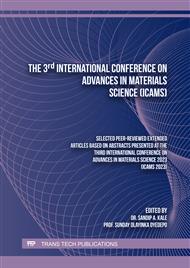[1]
Schirone Maria, Luigi Esposito, Federica D'Onofrio, Pierina Visciano, Maria Martuscelli, Dino Mastrocola, and Antonello Paparella. Biogenic amines in meat and meat products: a review of the science and future perspectives. Foods. 6 (2022) 788.
DOI: 10.3390/foods11060788
Google Scholar
[2]
Erdag Dincer, Oguz Merhan, and Baris Yildiz. Biochemical and pharmacological properties of biogenic amines. Biog. Amines. 8 (2018) 1-14
DOI: 10.5772/intechopen.81569
Google Scholar
[3]
Visciano, Pierina, Maria Schirone, and Antonello Paparella. An overview of histamine and other biogenic amines in fish and fish products. Foods. 12 (2020) 1795
DOI: 10.3390/foods9121795
Google Scholar
[4]
Qiao Chong, Fei Chen, Zhan Liu, Tianfang Huang, Wei Li, Guolin Zhang, and Yinggang Luo. Functional characterization of a catalytically promiscuous tryptophan decarboxylase from camptothecin-producing Camptotheca acuminata.. Front. Plant Sci. 13 (2022) 987348.
DOI: 10.3389/fpls.2022.987348
Google Scholar
[5]
Lai Yunjia, Chih-Wei Liu, Liang Chi, Hongyu Ru, and Kun Lu. High-resolution metabolomics of 50 neurotransmitters and tryptophan metabolites in feces, serum, and brain tissues using UHPLC-ESI-Q exactive mass spectrometry. ACS omega, 12 (2021) 8094-8103.
DOI: 10.1021/acsomega.0c05789
Google Scholar
[6]
Zhang Dianwei, Yanping Wang, Weitao Geng, and Huilin Liu. Rapid detection of tryptamine by optosensor with molecularly imprinted polymers based on carbon dots-embedded covalent-organic frameworks. Sens. Actuators B: Chem. 285 (2019) 546-552.
DOI: 10.1016/j.snb.2019.01.092
Google Scholar
[7]
Barbieri Federica, Chiara Montanari, Fausto Gardini, and Giulia Tabanelli. Biogenic amine production by lactic acid bacteria: A review. Foods. 1 (2019) 17.
DOI: 10.3390/foods8010017
Google Scholar
[8]
Vinci, Giuliana, and Lucia Maddaloni. Biogenic amines in alcohol-free beverages. Beverages. 1 (2020) 17.
DOI: 10.3390/beverages6010017
Google Scholar
[9]
Moniente Marta, Laura Botello‐Morte, Diego García‐Gonzalo, Rafael Pagán, and Ignacio Ontañón. Analytical strategies for the determination of biogenic amines in dairy products. Compr. Rev. Food Sci. Food Saf. 4 (2022) 3612-3646.
DOI: 10.1111/1541-4337.12980
Google Scholar
[10]
Rejithamol R, and S. Beena. Electrochemical quantification of pyridoxine (VB 6) in human blood from other water-soluble vitamins. Chem.pap.74 (2020) 2011-2020.
DOI: 10.1007/s11696-019-01049-5
Google Scholar
[11]
Krishnan Rajasree G, R. Rejithamol, and Beena Saraswathyamma. Non-enzymatic electrochemical sensor for the simultaneous determination of adenosine, adenine and uric acid in whole blood and urine. Microchem.j.55 (2020) 104745.
DOI: 10.1016/j.microc.2020.104745
Google Scholar
[12]
Krishnan Rajasree G, Beena Saraswathyamma, T. Anjana Raj, and M. G. Gopika. Poly (riboflavin) modified pencil graphite for the simultaneous electrochemical determination of serotonin and dopamine. In AIP Conference Proceedings, 2259 AIP Publishing, 2020.
DOI: 10.1063/5.0015807
Google Scholar
[13]
Jacob Dona, P. A. Mini, Avinash Balakrishnan, S. V. Nair, and K. R. V. Subramanian. Electrochemical behaviour of graphene–poly (3, 4-ethylenedioxythiophene) (PEDOT) composite electrodes for supercapacitor applications. Bull.Mater.Sci (2014) 61-69.
DOI: 10.1007/s12034-013-0610-9
Google Scholar
[14]
Rajamani A. R., Rajesh Kannan, Sruthy Krishnan S, Ramakrishnan S, Mohan Raj, D. Kumaresan, Nikhil Kothurkar, and Murali Rangarajan. Electrochemical sensing of dopamine, uric acid and ascorbic acid using tRGO-TiO2 nanocomposites. J. Nanosci. Nanotechnol.7 (2015) 5042-5047.
DOI: 10.1166/jnn.2015.9876
Google Scholar
[15]
Vadivaambigai A, Prem Anandh Senthilvasan, Nikhil Kothurkar, and Murali Rangarajan. Graphene-oxide-based electrochemical sensor for salicylic acid. Nanosci. Nanotechnol. Lett,, 2 (2015) 140-146
DOI: 10.1166/nnl.2015.1909
Google Scholar



